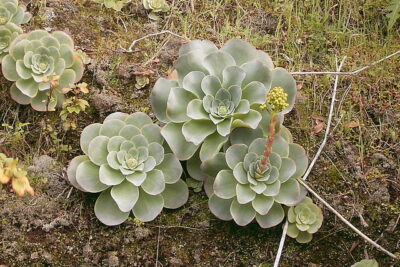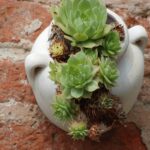
Can You Successfully Grow Lotus Lithops Succulents Indoors?

Lotus lithops, also known as living stones, are unique and fascinating succulent plants that are native to southern Africa. These plants have evolved to survive in extremely arid conditions and have developed a distinctive camouflage that helps them blend in with their rocky surroundings. While they are commonly found in their natural habitat, many succulent enthusiasts wonder if it is possible to successfully grow lotus lithops indoors.
We will explore the feasibility of growing lotus lithops succulents indoors. We will discuss the ideal growing conditions for these plants, including light, temperature, and soil requirements. Additionally, we will provide tips on how to care for lotus lithops and address common challenges that may arise when attempting to cultivate them indoors. By the end of this article, you will have a better understanding of whether or not it is possible to successfully grow lotus lithops succulents indoors and the steps you can take to ensure their health and vitality.
- Yes, you can successfully grow Lotus Lithops succulents indoors
- Provide them with bright, indirect light
- Use well-draining soil tailored for succulents
- Water them sparingly and only when the soil is completely dry
- Keep the temperature around 70-80°F (21-27°C)
- Provide good airflow and ventilation
- Avoid overwatering or keeping them in humid conditions
- Fertilize them once or twice a year with a diluted succulent fertilizer
- Repot them when necessary to prevent overcrowding
- Regularly inspect them for pests or diseases
- Enjoy the unique beauty of your Lotus Lithops succulents indoors
- Frequently Asked Questions
Yes, you can successfully grow Lotus Lithops succulents indoors
Lithops succulents, commonly known as living stones or pebble plants, are fascinating plants with a unique appearance. Their ability to mimic stones or pebbles serves as a natural defense mechanism against herbivores. One popular variety of Lithops is the Lotus Lithops, which showcases vibrant colors and intricate patterns.
Growing Lotus Lithops indoors can be an exciting and rewarding experience for succulent enthusiasts. Although they are native to the deserts of South Africa, these plants can thrive in indoor environments if provided with the right conditions.
Light
Proper lighting is crucial for the growth and development of Lotus Lithops. These plants prefer bright, indirect light, mimicking the conditions they would experience in their natural habitat. Place them near a south-facing window or use grow lights to ensure they receive sufficient light throughout the day.
Temperature
Lotus Lithops prefer warm temperatures ranging from 70 to 80 degrees Fahrenheit (21 to 27 degrees Celsius) during the day. At night, they can tolerate slightly cooler temperatures, around 50 to 60 degrees Fahrenheit (10 to 15 degrees Celsius). Avoid placing them in drafty areas or near air conditioning vents, as sudden temperature changes can stress the plants.
 Can You Keep Succulents Indoors Year-Round?
Can You Keep Succulents Indoors Year-Round?Watering
One of the most important aspects of caring for Lotus Lithops is proper watering. These succulents have unique watering needs due to their ability to store water in their leaves. It is crucial to mimic their natural watering patterns to avoid overwatering, which can lead to root rot.
Watering should be done sparingly, allowing the soil to dry out completely between each watering. During the active growing season, which typically occurs in spring and autumn, water the plants lightly, ensuring the water reaches the roots. However, during the dormant period, which occurs in summer and winter, reduce watering significantly to prevent rotting.
Soil and Potting
Choosing the right soil and potting mix is essential for the successful growth of Lotus Lithops. These plants require well-draining soil to prevent excess moisture retention. A mixture of cactus potting mix and perlite or pumice works well for creating a suitable growing medium.
When potting Lotus Lithops, select a shallow container with adequate drainage holes. The shallow depth mimics their natural growing conditions and prevents water from pooling at the roots.
Fertilizing
Lotus Lithops have modest fertilizer requirements. During the active growing season, you can use a diluted liquid fertilizer specifically formulated for succulents. However, it is crucial to follow the manufacturer's instructions and avoid over-fertilizing, as excessive nutrients can harm these delicate plants.
Note: Remember to always research and follow specific care instructions for the particular variety of Lotus Lithops you are growing, as some variations may have slightly different requirements.
With the right care and attention to their specific needs, you can successfully grow Lotus Lithops succulents indoors. These unique and captivating plants can add a touch of nature's artistry to any indoor space.
 Indoor vs Outdoor: Ideal Growing Environments for Succulents
Indoor vs Outdoor: Ideal Growing Environments for SucculentsProvide them with bright, indirect light
When it comes to growing Lotus Lithops succulents indoors, one of the most important factors to consider is providing them with bright, indirect light. These unique succulents thrive in bright light, but direct sunlight can be too intense and may cause their leaves to burn or turn yellow.
To ensure they receive the right amount of light, place your Lotus Lithops succulents near a window with filtered sunlight or use a sheer curtain to diffuse the light. If natural light is limited in your space, you can also use artificial grow lights specifically designed for succulents to provide them with the necessary light spectrum.
Remember, the key is to mimic their natural habitat where they receive bright light without being exposed to harsh sun rays.
Use well-draining soil tailored for succulents
When it comes to successfully growing Lotus Lithops succulents indoors, one of the most important factors to consider is the type of soil you use. These unique plants require well-draining soil that is tailored specifically for succulents.
The ideal soil for Lotus Lithops should be a mix of sandy, gritty, and loamy components. This combination allows for proper drainage, preventing waterlogged roots which can lead to root rot and other issues. You can either purchase pre-made succulent soil from your local garden center or create your own mix by combining equal parts of regular potting soil, coarse sand, and perlite.
 Optimal Indoor Lighting for Succulents: Sunlight or Not?
Optimal Indoor Lighting for Succulents: Sunlight or Not?It's important to note that Lotus Lithops are native to arid regions and are adapted to survive in low-nutrient environments. Therefore, it's best to avoid using nutrient-rich soil or adding fertilizers to the mix. These plants thrive in lean soil conditions, so keeping the soil relatively infertile will help mimic their natural habitat.
When potting your Lotus Lithops, make sure to choose a container with drainage holes. This allows excess water to escape, preventing waterlogging. Additionally, using a shallow container is recommended as it mimics the shallow root system of these succulents.
Tip: To further enhance drainage, you can place a layer of small rocks or pebbles at the bottom of the pot before adding the soil mix.
Water them sparingly and only when the soil is completely dry
One of the most important factors to consider when growing Lotus Lithops succulents indoors is the watering schedule. These unique plants have adapted to survive in arid environments, so they prefer dry conditions. It is crucial to water them sparingly and only when the soil is completely dry.
Overwatering can be detrimental to Lotus Lithops as it can lead to root rot and other issues. Therefore, it is essential to wait until the soil has dried out before giving them a good soak. You can check the moisture level by using a moisture meter or simply by sticking your finger about an inch into the soil. If it feels dry, it's time to water.
Keep the temperature around 70-80°F (21-27°C)
Growing Lotus Lithops succulents indoors can be a rewarding and fascinating experience. These unique plants, also known as Living Stones, are native to South Africa and are highly sought after for their striking appearance and ability to mimic rocks.
 Can Succulents Thrive Indoors Without Sunlight?
Can Succulents Thrive Indoors Without Sunlight?One of the most important factors to consider when growing Lotus Lithops succulents indoors is maintaining the right temperature. These plants thrive in warm environments, so it is crucial to keep the temperature around 70-80°F (21-27°C). This can be achieved by placing them in a well-insulated area or using a space heater or heating mat.
Provide good airflow and ventilation
When it comes to successfully growing Lotus Lithops succulents indoors, one of the most important factors to consider is providing good airflow and ventilation. This is crucial for maintaining the health and well-being of your plants.
Proper airflow helps prevent the buildup of excess moisture, which can lead to root rot and other fungal diseases. It also helps regulate the temperature and humidity levels around your plants, creating an optimal environment for their growth.
To ensure good airflow and ventilation, there are a few steps you can take:
- Choose the right container: Opt for containers with drainage holes at the bottom. This allows excess water to escape and prevents it from sitting in the pot, promoting better airflow.
- Position your plants strategically: Place your Lotus Lithops succulents in an area where they can receive adequate air circulation. Avoid crowding them together or placing them in a location with poor ventilation, such as a closed cabinet or tight corner.
- Use a fan: Consider using a small fan near your plants to create gentle air movement. This can help prevent stagnant air and promote better ventilation. Be sure to adjust the fan speed and direction based on the specific needs of your succulents.
- Open windows or use a dehumidifier: If your indoor space tends to be humid, opening windows or using a dehumidifier can help reduce excess moisture in the air. This, in turn, improves airflow and prevents the risk of fungal diseases.
By taking these measures to provide good airflow and ventilation, you can create a healthy indoor environment for your Lotus Lithops succulents to thrive.
Avoid overwatering or keeping them in humid conditions
When it comes to successfully growing Lotus Lithops succulents indoors, one of the most important factors to consider is avoiding overwatering and keeping them in humid conditions. These unique succulents, also known as living stones, have adapted to survive in arid desert environments, making them highly sensitive to excess moisture.
 Can Succulents Flourish with Grow Lights?
Can Succulents Flourish with Grow Lights?Overwatering can be detrimental to the health of your Lotus Lithops. It can lead to root rot, causing the plant to wither and eventually die. Therefore, it is crucial to follow a strict watering schedule and ensure that the soil is completely dry before watering again. As a general rule, water your Lotus Lithops sparingly, approximately once every 2-3 weeks during the growing season, and even less frequently during the dormant period.
Additionally, it is important to keep your Lotus Lithops away from humid conditions. High humidity levels can promote the growth of fungus and mold, which can also lead to root rot. Therefore, it is recommended to place your succulents in a well-ventilated area with good air circulation. Avoid placing them in rooms with high levels of humidity, such as bathrooms or kitchens.
Furthermore, providing adequate drainage for your Lotus Lithops is crucial. Plant them in a well-draining soil mixture specifically formulated for succulents or cacti. This will prevent excess moisture from accumulating around the roots, reducing the risk of root rot.
To summarize, in order to successfully grow Lotus Lithops succulents indoors, it is essential to avoid overwatering, keep them away from humid conditions, and provide proper drainage. By following these guidelines, you can create a suitable environment for your Lotus Lithops to thrive and enjoy their unique beauty.
Fertilize them once or twice a year with a diluted succulent fertilizer
When it comes to successfully growing Lotus Lithops succulents indoors, proper fertilization is key. These unique plants have specific nutrient requirements that need to be met in order for them to thrive. One important aspect of fertilization is the frequency at which it should be done. For Lotus Lithops succulents, it is recommended to fertilize them once or twice a year.
When choosing a fertilizer for your Lotus Lithops succulents, it is crucial to opt for a diluted succulent fertilizer. This type of fertilizer is specifically formulated to meet the nutritional needs of succulent plants like the Lotus Lithops. The concentration of nutrients in succulent fertilizers is lower compared to regular plant fertilizers, which helps prevent over-fertilization and potential damage to the plants.
Applying the fertilizer to your Lotus Lithops succulents is a simple process. Start by diluting the succulent fertilizer according to the instructions provided on the packaging. It is important to follow the recommended dilution ratio to avoid any adverse effects on the plants. Once the fertilizer is properly diluted, you can apply it to the soil around the base of the succulents. Take care to avoid getting any fertilizer on the leaves or stems, as this can lead to burning or other damage.
 Can Mother of Thousands Succulents Thrive Indoors?
Can Mother of Thousands Succulents Thrive Indoors?By fertilizing your Lotus Lithops succulents once or twice a year with a diluted succulent fertilizer, you are providing them with the necessary nutrients to support their growth and overall health. Remember to always follow the instructions on the fertilizer packaging and be cautious not to over-fertilize. With proper fertilization, your Lotus Lithops succulents can thrive and add a touch of beauty to your indoor space.
Repot them when necessary to prevent overcrowding
One important aspect of successfully growing Lotus Lithops succulents indoors is to repot them when necessary. These unique plants have a slow growth rate but can eventually outgrow their containers if left undisturbed for too long. Therefore, it is crucial to keep an eye on their growth and provide adequate space for their roots to expand.
When repotting Lotus Lithops, it is essential to choose a well-draining potting mix specifically formulated for succulents. This ensures that excess moisture is properly drained, preventing root rot and other issues caused by waterlogging. Additionally, using a pot with drainage holes allows for excess water to escape, further promoting a healthy root system.
Here are some steps to follow when repotting your Lotus Lithops succulents:
- Carefully remove the plant from its current container, gently loosening the soil around the roots.
- Inspect the roots for any signs of damage or rot. Trim off any unhealthy roots using clean, sharp scissors or pruning shears.
- Select a slightly larger pot with drainage holes that will accommodate the plant's current size and provide room for future growth.
- Fill the new pot with a well-draining succulent potting mix, leaving enough space at the top for the plant.
- Place the Lotus Lithops in the center of the pot, ensuring that the roots are spread out evenly and not cramped.
- Gently backfill the pot with the potting mix, pressing it down lightly to secure the plant in place.
- Water the succulent lightly, allowing the soil to absorb moisture without becoming waterlogged. Avoid overwatering as it can be detrimental to the plant's health.
- Place the repotted Lotus Lithops in a bright location with indirect sunlight. These plants thrive in bright light conditions but can get sunburned if exposed to intense, direct sunlight.
- Monitor the plant's growth and adjust watering and lighting accordingly to provide optimal conditions for its development.
Remember, repotting is not a frequent requirement for Lotus Lithops succulents, but it is essential to prevent overcrowding and maintain healthy growth. By following these steps and providing the right conditions, you can successfully grow Lotus Lithops succulents indoors and enjoy their stunning beauty in your home.
Regularly inspect them for pests or diseases
Regularly inspecting your Lotus Lithops succulents for pests or diseases is crucial to their overall health and success indoors. Pests such as aphids, mealybugs, and spider mites can quickly infest your plants if left unchecked. These pests feed on the sap of the plants, causing damage to the leaves and stems.
 Growing Succulents on Trees: A Unique Outdoor Garden Idea
Growing Succulents on Trees: A Unique Outdoor Garden IdeaTo prevent and control pest infestations, regularly examine the leaves and stems of your succulents for any signs of pests. Look for small insects, webs, or sticky residue on the plant's surface. If you notice any pests, immediately take action to eliminate them.
One effective method to control pests is to gently wipe the affected areas with a cotton swab dipped in rubbing alcohol. This will kill the pests and remove any sticky residue left behind. Alternatively, you can also use insecticidal soap or neem oil spray to get rid of pests. Be sure to follow the instructions on the product label for safe and effective use.
In addition to pests, it is also important to keep an eye out for any signs of diseases in your Lotus Lithops succulents. Common diseases that can affect succulents include fungal infections, root rot, and bacterial infections. These diseases can cause discoloration, wilting, and even death of the plants if not addressed promptly.
To prevent diseases, make sure you provide proper care for your succulents, including well-draining soil, adequate airflow, and appropriate watering practices. Avoid overwatering your plants, as excess moisture can lead to root rot and other fungal infections.
If you notice any signs of diseases, such as discolored or mushy leaves, remove the affected parts immediately to prevent the spread of the disease. You can also apply a fungicide or bactericide to the remaining healthy parts of the plant to prevent further infection.
By regularly inspecting your Lotus Lithops succulents for pests or diseases and taking appropriate action when necessary, you can ensure their successful growth and longevity indoors.
Enjoy the unique beauty of your Lotus Lithops succulents indoors
 Easy Tips for Indoor Succulent Care: A Guide to Succulent Success!
Easy Tips for Indoor Succulent Care: A Guide to Succulent Success!Lotus Lithops succulents are known for their unique and captivating beauty. With their distinctive pebble-like appearance and vibrant colors, they make a wonderful addition to any indoor plant collection. But can you successfully grow Lotus Lithops succulents indoors?
The answer is yes, you can! While these succulents are typically found in arid regions and are well-suited to outdoor environments, with the right care and conditions, you can cultivate a thriving indoor garden of Lotus Lithops succulents.
Essential Tips for Successfully Growing Lotus Lithops Succulents Indoors
To ensure the success of your indoor Lotus Lithops succulents, consider the following essential tips:
- Provide Adequate Lighting: Lotus Lithops succulents require bright, indirect sunlight for at least 6-8 hours a day. Place them near a sunny window or use artificial grow lights to supplement their light needs.
- Control Temperature and Humidity: These succulents prefer warm temperatures ranging from 70-80°F (21-27°C) during the day and slightly cooler temperatures at night. Additionally, they thrive in low humidity environments, so avoid placing them in areas with high moisture levels.
- Use Well-Draining Soil: Lotus Lithops succulents require well-draining soil to prevent root rot. Use a cactus or succulent-specific potting mix that provides excellent drainage.
- Water Sparingly: Overwatering is the most common mistake when caring for Lotus Lithops succulents. Allow the soil to dry out completely between waterings and then provide a deep, thorough watering. During the winter months, reduce watering frequency as the plants enter a dormant phase.
- Avoid Fertilizing: Lotus Lithops succulents do not require frequent fertilization. In fact, excessive fertilization can harm these plants. It is best to avoid fertilizing altogether or only apply a diluted, balanced fertilizer sparingly during the growing season.
By following these tips, you can create an ideal environment for your Lotus Lithops succulents to thrive indoors. Remember to observe your plants closely and adjust care as needed. With patience and proper attention, you can enjoy the unique beauty of these extraordinary succulents in the comfort of your own home.
Frequently Asked Questions
 Can Succulents Survive Outdoors All Year?
Can Succulents Survive Outdoors All Year?1. Can You Successfully Grow Lotus Lithops Succulents Indoors?
Yes, you can successfully grow Lotus Lithops succulents indoors as long as they receive bright indirect light and are planted in well-draining soil.
2. How often should I water my Lotus Lithops succulents?
Lotus Lithops succulents are drought-tolerant, so it is best to water them sparingly. Water them only when the soil is completely dry, usually every 2-4 weeks.
3. What is the ideal temperature range for Lotus Lithops succulents?
 Can a Star Flower Succulent Survive and Thrive Indoors?
Can a Star Flower Succulent Survive and Thrive Indoors?Lotus Lithops succulents prefer temperatures between 65°F and 85°F (18°C to 29°C). They can tolerate higher temperatures, but it is important to avoid extreme heat.
4. Do Lotus Lithops succulents require any special care?
Lotus Lithops succulents require minimal care. They thrive in well-draining soil, bright indirect light, and low humidity. Avoid overwatering and provide occasional fertilization during the growing season.
If you want to read more articles similar to Can You Successfully Grow Lotus Lithops Succulents Indoors?, you can visit the Indoor and Outdoor Care category.






You Must Read